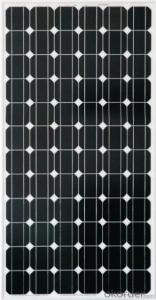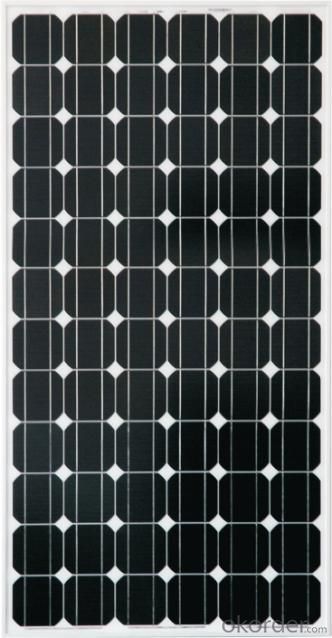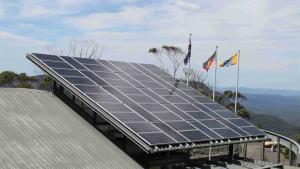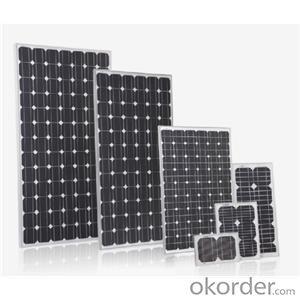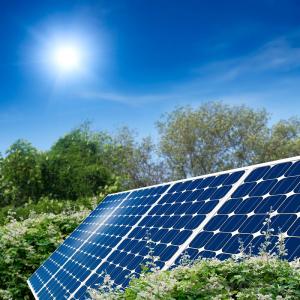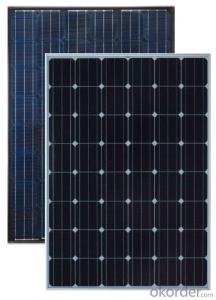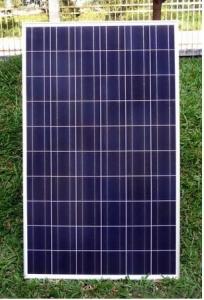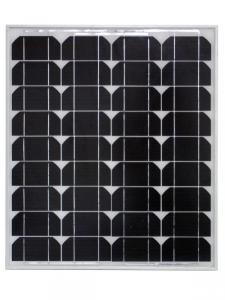200 Watt Flexible Solar Panels - Monocrystalline Solar Module 205W
- Loading Port:
- China Main Port
- Payment Terms:
- TT OR LC
- Min Order Qty:
- -
- Supply Capability:
- -
OKorder Service Pledge
OKorder Financial Service
You Might Also Like
Solar Monocrystalline (210W-225W)
Introduction of Solar Monocrystalline (210W-225W)
Solar modules use light energy (photons) from the sun to generate electricity through the photovoltaic effect. The majority of modules use wafer-based crystalline silicon cells or thin-film cells based on cadmium telluride or silicon. The structural (load carrying) member of a module can either be the top layer or the back layer. Cells must also be protected from mechanical damage and moisture. Most solar modules are rigid, but semi-flexible ones are available, based on thin-film cells. These early solar modules were first used in space in 1958.
CNBM Solar photovoltaic (PV) Panel is designed for large electrical power requirements. It is the optimal choice for both on-grid and off-grid power systems. CNBM Solar panel offers high performance of power per square foot of solar array. Monocrystalline silicon(c-Si): often made using the Czochralski process. Single-crystal wafer cells tend to be expensive, and because they are cut from cylindrical ingots, do not completely cover a square solar cell module without a substantial waste of refined silicon. Hence most c-Si panels have uncovered gaps at the four corners of the cells.
Characteristics of Solar Monocrystalline (210W-225W)
I. Solar Cell : High efficiency crystalline solar cell. Even if under the weak light, the solar module can produce maximum power output.
II. Tempered glass (toughened glass): Anti-reflecting coating and high transmission rate glass increase the power output and mechanical strength of solar module.
III. EVA and TPT: Using high quality EVA and TPT to prevent destroying and water.
IV. AI frame: Without screw, corner connection. 6 holes on the frame can be installed easily.
V. Junction box: Multi function junction box with water proof.
VI. Long lifetime: ≥25 years; Less power decrease.
VII. Good performance of preventing from atrocious weather such as wind and hails.
VIII. Resisting moisture and etching effectively, not effected by geology.
IX. The certificate issued by international authority: UL, TUV, IEC, VDE, CE.
Standard Test Conditions of Solar Monocrystalline (210W-225W)
The opto-electrical specifications shown below are stabilized values being measured at Standard Test Conditions, Irradiance: 1000W/m2, Spectrum: AM1.5 at 25°C, The info below is subject to manufacturing tolerances. Where appropriate minutes of measurement are available and are used for the dimensioning of the installation.
Advantages of Solar Monocrystalline (210W-225W)
• CNBM Solar performance guarantees for 25 years
• 10 years guarantee for workmanship
• Timeliness of delivery
• Quality Products certified (TÜV, UL, CE, VDE, ISO)
CNBM International Corporation's products including Monocrystalline Solar Panel, Polycrystalline Solar Panel have received and enjoyed famous reputation in many countries and regions in the world .As a solar panel manufacturer in China, we strive to provide our customers with excellent service, superior products and unmatched value.
- Q: I need to be able to charge a 2v 7amp battery with a solar panel. I understand that the charge controller will keep the battery from over charging/discharging, but what I don't understand is the amps.The solar panel is rated at 5watts.The solar panel comes with a 2v 3amp charge controller but will I need to buy a 7amp charge controller and replace it with that for my battery pack? Please explain. Thanks in advance.
- If it is a charge controller that is wired between the panel and the battery only, then a 3A rating is ample. The controller only has to handle the maximum current that the solar panel can output. The panel will have (or needs to have) an open-circuit voltage that is greater than about 4V in order to actually charge the battery, whose terminal voltage will rise above 2V as it charges. The panel's open circuit output voltage typically is about 7V. The 5W rating is at the maximum power point under the illumination of standard sun and at a specified temperature. That maximum power point probably is around 4V, which means the panel will deliver the following amperage to charge the battery: I = P/V = 5W/4V = 0.36A Since 0.36A is well below the 3A rating of the controller, the controller will not be overloaded when charging the battery. Some charge controllers also have terminals for connecting the load that you want to power. If that's the case, then the controller also needs to be rated to handle that load amperage or higher. If you were to connect a 6A load, then you would like to have say a 0A controller. Hope that helps.
- Q: I'm looking for a solar panel that has something you can plug thigs into, I don't know let's say grow lights. I want something that these lights can plug directly into and I can't find any online. If there is any I would like to know of the cheapest and best quality, I know that's an oxymoron but still. The lights are 600 watts so I need something somewhat strong. Thanks
- Homemade okorder
- Q: Do solar panels work in cloudy weather?
- Solar panels can still generate electricity in cloudy weather, though their efficiency may be reduced.
- Q: If a solar panel is a .5kW system, what length of time is it putting out that much power? Every hour?
- Power = work done/time taken In other words, Watts=Joules/second. In this respect, power is a little like speed (m/s). Your question is looking at a car with a 50mph top speed, and asking how long is it going that fast? The solar panel will produce .5KW for as long as you require it. Enough to boil a kettle, run a modest electric heater etc,
- Q: When you add a load resistor to a PV panel (Solar panel) of 00 ohms what happens to the voltage produced from the cellAlso, as the resistance increases, how does this affect the output voltage
- Look at the graph data that looks like a rotated L. That is what voltage as a function of current characteristically behaves. The highest voltage value is called open circuit voltage (Voc). The current at lowest voltage value is called short circuit current (Isc). If you notice, a second curve is plotted that looks like a hill. That curve is power output as a function of voltage. At the peak of said hill, you get the most utility of your PV module, as you output the maximum power possible, and that is the nameplate value for the PV module's power rating.
- Q: Can solar panels be used in areas with high wind speeds?
- Yes, solar panels can be used in areas with high wind speeds. However, it is important to ensure that the solar panel installation is designed and engineered to withstand the specific wind conditions in the area. This may involve using specialized mounting systems and ensuring proper anchoring and structural reinforcement to prevent damage or dislodgement due to strong winds.
- Q: Can solar panels be used for irrigation systems?
- Yes, solar panels can be used to power irrigation systems. Solar energy can be harnessed by the panels and converted into electricity, which can then be used to run pumps and other components of an irrigation system. This renewable energy source offers a sustainable and cost-effective solution for powering irrigation systems, especially in remote or off-grid areas.
- Q: but is that per day, per hour or minute?How much watts does the average AC unit use?How much does an energy efficient lightbulb use?All in all let's hypothetically say we no longer use the electric company for our energy source, How many of these panels do you estimate it would take to supply our small home?
- Some great answers 23 max watts is per hour I live in an area that has 5.5 average sun hours per the solar insolation data which would give me a base of 676 watts produced per day for one panel. That 23 watts is most likely STC or standard test conditions which is far from standard it is ideal 70 degrees Farenheit with a 000 set flash PTC or physical test conditions are not always on labels and are not always accurate because of varied conditions. Heat has a huge factor on PV production. The panels should be derated by for the following reason ampacity correction or line loss Temperature correction PTC correction Inverter loss these corrections account for about 5 % on standard panels Our 676 watts per day has been dropped to 574 watts per day per panel Lets start with the light bulb. a standard 60 watt bulb uses 60 watts per hour. With the one panel we have chosen it would produce 5 hours and 45 minutes of illumination If we switch to a 5w CFL we get 38 and one half hours of illumination quite a difference yes Central Air will use about 2000 to 2500 watts per hour.This rule is not hard and fast as units will vary as well as conditions Lets use 2000 per hour times 8 hours of use is 6,000 watts we need 28 panels just for the ac. Probably another 28 for the rest of the house Of course these panel must be true south at 5 degrees mounted With a years worth of electric bills and a site visit I could come allot closer but lets say you need 60 of these panels this system would provide 973kHw per month at my location of 5.5 sun hours per day This would be a grid tied system as most state rebates require a grid tied system to qualify for rebates
- Q: Can solar panels be installed on a commercial building?
- Yes, solar panels can be installed on a commercial building. In fact, many businesses are opting for solar panel installations as a way to reduce energy costs, promote sustainability, and take advantage of government incentives. Commercial buildings provide ample space for solar panels to be installed on rooftops or as ground-mounted systems, allowing businesses to generate clean energy and contribute to a greener future.
- Q: How do solar panels affect the roof's structure and integrity?
- Solar panels can have some impact on the roof's structure and integrity, but they are designed to be lightweight and installed without compromising the roof's stability. Properly installed solar panels distribute the weight evenly, reducing the likelihood of any structural damage. Additionally, solar panels can help protect the roof by shielding it from the elements, potentially extending its lifespan. However, it is crucial to consult with a professional to ensure proper installation and minimize any potential impact on the roof.
Send your message to us
200 Watt Flexible Solar Panels - Monocrystalline Solar Module 205W
- Loading Port:
- China Main Port
- Payment Terms:
- TT OR LC
- Min Order Qty:
- -
- Supply Capability:
- -
OKorder Service Pledge
OKorder Financial Service
Similar products
Hot products
Hot Searches
Related keywords
